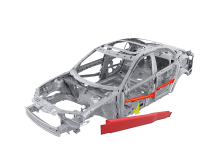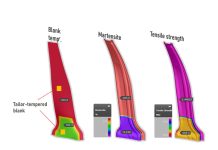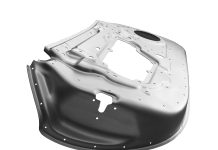How Effective is CFD Technology Really? Michael Düring Interview
[dropcap]O[/dropcap]ne of the arguments heard in the world of sheet metal forming simulation is that it’s not enough to merely compute the temperature distribution for hot forming. It is purported that you further have to compute the flow conditions inside the cooling channels themselves in order to obtain accurate forming simulation results. Michael Düring from AutoForm Netherlands clears up the issue once and for all.
This is Part 2 of our hotforming series, see part 1 here. Michael Düring, Product Manager at AutoForm, in this interview, challenges the view that CFD technology is necessary. In fact, he argues that it’s an overkill that yields little additional accuracy. Not one to merely make sweeping statements he joined this interview with science to back up his argument.
Michael, please describe the issue of CFD (Computation Fluid Dynamics).
‘Right now there are companies affirming that it is not enough to just compute the temperature distribution of the tools, but that you further have to compute the flow conditions inside the cooling channels. They say they can compute the inhomogenities of the flow conditions of the cooling medium itself, and the resulting inhomogeneous heat transfer coefficient between the tool and the cooling medium itself. Theoretically this would be a higher level of accuracy one could achieve and they claim that process engineers need it. The decision on whether or not to make use of a CFD-approach to simulate the cooling process in hotforming tools has a significant impact on the efforts and costs that come with this technology. Herein lays the problem; users of simulation often depend upon software vendors to describe its functionality. However end users are typically process engineers, and not 100% specialists in FE-simulation. How are they to know what is really necessary and even effective without an extensive background in numerical simulation technology?’
Michael then put the idea to the test, examining CFD simulations vs. AutoForm simulations to check the results and final hardness of the part. The results were interesting to say the least.
‘Firstly it is true that there isn’t a homogenous temperature distribution or heat transfer in the water. So, it’s safe to say the water within, whilst doing its work of cooling, runs through corner areas that are influencing the local heat balance since they cannot be represented as a single straight tube anymore where the water current conditions are in a single constant state all over the length. So you have variations in the cooling rate, that some claim need to be simulated. To model this in more detail you also need to consider that you have different heat transfer coefficients, because pressures are locally different, or because of those differences you must therefore have a different temperature in each of the cooling channels. Then, going even deeper, you have the entry point of the water, and the point where the water exits. The common speculation, even argument, is that all of this must be considered.’
‘To investigate this claim’ says Michael, ‘what we have assumed in the first analysis shown below is that you have a comprehensive integrity, from the starting point to the end, that in fact you have a quite low heat transfer coefficient, translating into low pressure and a low flow rate. This translates into laminar conditions – representing the worst case (from the cooling point of view).’
He then carried out a detailed analysis of the range of possible flow conditions to assess how the flow conditions might affect the outcome in the very worst case to draw a conclusion.

Fig 1: Temperature on Punch Surface – Laminar Flow in Cooling Channels
Michael then cut to the chase: ‘The data speaks for itself. The laminar flow is not only unnecessary but should also be avoided for saving time. Compared to what is achieved, ensuring turbulent flow in terms of minimum temperatures at the tool at a given cooling channel design, the laminar conditions are far less effective. How beneficial is it really to focus on each specific corner in the finish? The computation time is demanding, so I examined whether or not it’s really needed. Even though AutoForm offers manifold options to more realistically model varying HTCs along the cooling channels, in our experimental case study set-up we exemplarily consider everything bad, and everything good, and then assess what the influence would be under both extremes. It is in the space in between that we compute the sweet spot for hot forming conditions.’
Backing up his argument Michael provided the image below. It depicts how the study, following the most sophisticated approaches customers are using, analyzed the method for its effectiveness. The full study paper we will publish as Part 3 of this hotforming series.

Fig 2: Temperature on Punch Surface – Moderately Turbulent Flow in Cooling Channels.

Figure 3: Temperature on Punch Surface – Highly Turbulent Flow in Cooling Channels.
Images 2 and 3 both show results using turbulent flow conditions. Here moderate and highly turbulent conditions have been applied, and the results speak for themselves. Looking closely at the results, you have a variation of the maximum surface temperature of 154.8 (moderately turbulent) to 151.9 degrees Celsius (highly turbulent). The results mean that whether you have either good or poor turbulence conditions inside the cooling channels makes almost no difference for the tool surface temperatures.
Michael said ‘Some insist that because they can simulate the flow conditions their product must be better. Of course you can simulate each corner, and all the temperatures of those entry points and exit points, leading to an inhomogenous heat transfer coefficient. However, this has no impact on the actual sheet metal results, since the influence is too small. The question then is, why model all of this, why compute all of this through such an intense workload for such inconsequential changes in the simulation result?’
‘The claim made is that you’ll have even more accurate results for the temperature distribution of the tool surfaces when simulating flow conditions inside the cooling channels. What AutoForm has done by implementing cooling channel analysis capabilities, is empowering users to determine spots that have higher or lower temperatures. That is all that is needed. In even more complex systems one can assign different heat transfer coefficients – referring to lower flow rates or lower pressure values – to groups or even sections of cooling channels. What really matters is how this affects the hardness of the part. You can see that indeed, when you have really weak flow conditions, hardness is impacted unfavorably. Yet, ironically this has always been avoided seeing that no engineer starts with the laminar flow condition.’
‘When you have reasonable flow conditions, which you can set up generically, and then compute it using this model you’ll see that the difference in hardness is low. As a result all that work done using CFD simulations gives you nothing tangible. You do not get any improvement that merits the extra work involved. There will always be special use cases where it might apply. This is the danger of being duped (tricked into believing something), as for 99% of parts you’d be wasting your time.’

Figure 4: Exemplary Hardness Distribution in Part after Forming and Quenching
‘We found that in computing the flow conditions the impact was so negligible, and its effect was so slight in the end, that compared to working without it you would come to the same conclusion; that this is something which can safely be disregarded. We want to save our customers a lot of time in development which they can do if they move on.’ Michael Düring.
Thank you Michael for this engaging interview. Fans wait for more. In part three of this series we’ll publish the actual study from Michael. Subscribe to follow!














We use CFD in more challenging part and/or tool cases to help balance branch circuits, optimize channel designs to water chiller capacities, and to find air pockets that could create hotter tool spots. Filling the channels usually helps find the air pockets (which can usually be avoided by good experienced tool designers). It also helps understand imbalanced channel resistances that could starve a branch.
In most cases, however, we don’t see the value of using CFD due to our experienced team of Hot Form engineers, designers and technicians.